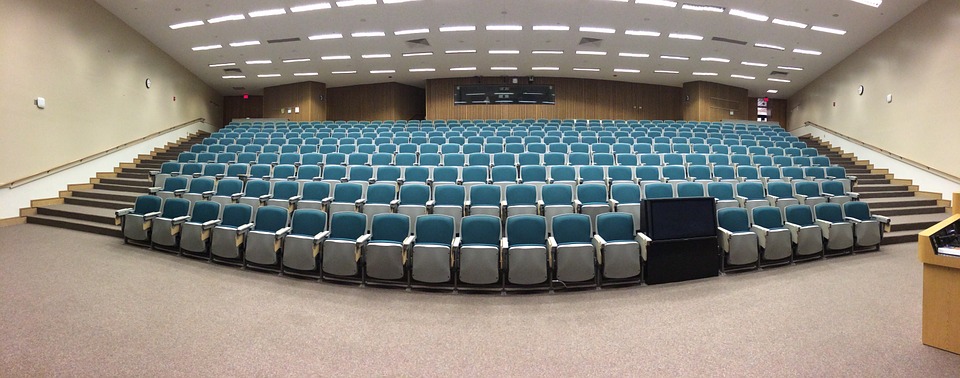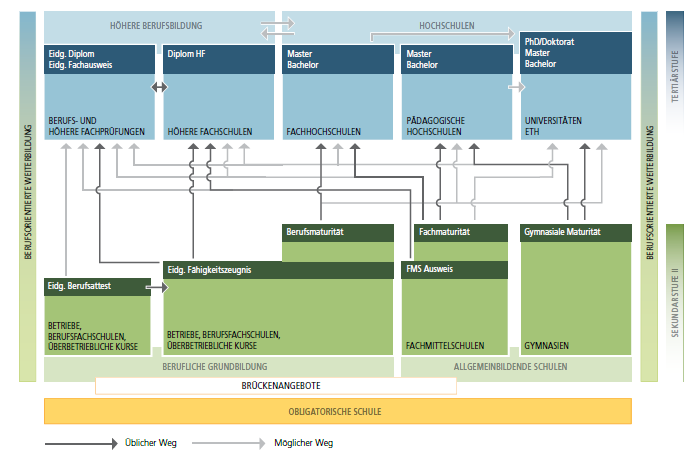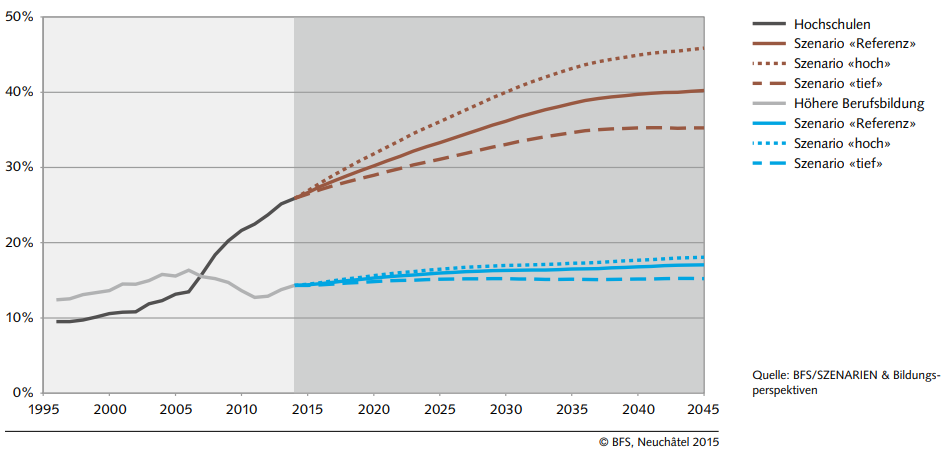Authors | Sources
Severin Renold
References in the text

Severin Renold
References in the text
Education system
Foreword
In the course of digitisation, easily digestible concepts become disruptive, processes are simplified and strategies have to be revised. The reasons for this are the characteristics of digital transformation, which offers a high degree of transparency and comparison possibilities, the trend of online trading, fast communication channels, as well as the options for increasing the profitability of companies through automation and optimization of internal and external processes. The conclusion is that almost everyone is affected by this change and yet is very cautious in educating the masses. This is exactly where digitalization begins, in the education and education of society about the above-mentioned topics. Reason enough to focus more on the latter and to look into the research question in the following report:
“How can educational centres such as colleges or universities lucratively expand their business models so that they can continue to grow profitably in the future?
Introduction
To this day, university concepts in the German-speaking world are similar to those that have been cultivated for over 100 years. This includes factors such as classroom teaching, which is a prerequisite for many modules, the compilation of the curriculum, which is usually specified by the university, and the fundamental focus on teaching specialist skills. However, with the change in technological possibilities and consumer behaviour in times of digitalisation, such institutions also have to think about innovations. Not because the demands on the qualification of employees have been reduced, on the contrary, but because more and more alternative offers are pushing their way onto the market from private sector constructs that substitute the classical education system. (University of the Future, Ulrich Dittler, p.7)
In the long run, and especially on the mass market, the skill level, methodological competence and practical applicability of know-how in everyday working life will ultimately decide whether the employment relationship will last beyond the probationary period. Whether the person in question then holds a Bachelor’s, Master’s or Dr. degree without the desired skills only has a marginal influence on further potential cooperation. In other words, the degree on paper will lose importance from time to time if the affected graduates do not clearly distinguish themselves from candidates from the private sector who have undergone further training in self-study, via learning platforms and tutorials or Youtube. They certainly have one thing in common: methodological competence and determination, whereby university graduates are primarily expected to have theoretical knowledge. How important will the applicable theory be in the future if artificial intelligence, machine learning or robotics are included in the discussion? Algorithms that far outdo human knowledge, are able to recognize correlations more quickly, do not cause careless mistakes and continuously optimize efficiency? Such fundamental challenges and upheavals entail great risks, but just as many opportunities that should be exploited. “When the wind of change blows, some build walls and others windmills” (Chinese wisdom).

For the university and university landscape, this means nothing less than adapting to tomorrow’s customers. To look at competition beyond one’s own competitive analysis and to rethink unique selling propositions. Now, signs can be set for a positive standing and the claim to stand out nationally from competitors, to become attractive also for international interested parties and to set new standards. In most cases, valuable insights can already be gained by comparing years of application practices with the channels that lead to decreasing enrolment rates, as mentioned earlier. A further milestone on the scale of knowledge is the orientation towards the conditions of the day after tomorrow, i.e. how the business models of the current disruptors in the education system could again be replaced or expanded. For example, through the combination of classical educational offers with the possibility of independently developing learning content. Or by adapting the subject area itself to future scenarios of digitisation, robotics and other advanced technologies. In the further course of this article, these options will be evaluated and presented.
State of research
The state of research shows that in today’s information society, the field of education is not spared by digitisation either. Thus the change triggers several consequences for the education sector with regard to the forms, contents and framework conditions of education. Not only the amount of information and knowledge to be conveyed is continuously increasing, but also the supply of digital educational media. At the same time, there is a growing need among students for mobile and individual educational offers that are flexible in terms of time, location and individual use (Albrecht & Revermann, p. 39). The anthology by Dittler and Kreidl names the following components of teaching 4.0 for an individualized, goal-oriented and digital learning process, which were identified by Popp and Ciolacu 2017:
A personalised learning environment allows students to compile content, learning resources and learning tools individually according to their needs. Mobile devices enable learners to network online and exchange information interactively.
An adaptive learning environment offers the possibility of adapting the learning content to the learning behaviour and previous knowledge of the students. Examples of this could be introductory examinations or pre- and post-processing orders for the learning content.
A Learning Analytics system enables endangered students to be identified at an early stage and individual and appropriate action can be taken.
E-Assessments and chatbots act as support for learners. In this way e-assessments can minimize the examination effort and chatbots can take over part of the communication between lecturers and students. (Pauschenwein & Lyon, 2018, p. 150)
In July 2017, the Department of Economics, Education and Research (WBF) of the Swiss Confederation published an article on fields of action in the field of education. The article describes that there are currently no more recent and complete studies on the digital infrastructure and the use of information and communication technology in Swiss schools. However, the ICILS study in 2013 shows that good resources such as exercise and training programmes as well as graphics, drawing and presentation applications are available to schools. According to the Department, this potential and the resulting advantages of using digital media should be fully exploited in the future (Department of Economics, Education and Research WBF, 2017, pp. 35-39).

Industry description
In Switzerland, education, from compulsory schooling to tertiary level, is a state task. This means that the 26 cantons of Switzerland are primarily responsible for education. 90% of the financing of education expenditure is borne by the public sector. (http://www.edk.ch/dyn/14798.php) Education is divided into four levels, namely primary, lower and upper secondary and tertiary. The latter is subdivided into the two areas of higher vocational education and training and higher education and thus includes, in addition to federal diplomas at higher technical colleges, Bachelor’s degree programmes at universities.
Swiss higher education landscape
Switzerland’s higher education system consists of universities, universities of applied sciences and universities of teacher education. All three have aligned their courses to two levels of study in accordance with the “Bologna system”. This means that, in addition to continuing education courses, both Bachelor’s and Master’s programmes are offered, both of which are modularised and evaluate students’ performance on the basis of European Credit Transfer and Accumulation System (ECTS) points.
Higher vocational education and training appeals to experienced professionals and offers them the possibility of specialisation or further qualification. Universities of applied sciences prepare graduates for demanding tasks and teach them the necessary methods to successfully master them. They are more practice-oriented than universities. (Federal Statistical Office, 2015, p. 5-6) The Swiss higher education landscape includes seven public and one private universities of applied sciences, all of which were under federal sovereignty from the outset and are supported by one or more cantons. (State Secretariat for Education, Research and Innovation SBFI, 2018) The graduation rate at tertiary level is over 45%, of which about two thirds are university degrees and about one third higher vocational education degrees.
Switzerland’s education system is characterised by a high degree of permeability. In other words, there are various ways of entering or transferring to vocational training or a school or catching up on vocational training. In addition, there is open access to the various educational offers. In other words, those who have the necessary qualifications can, in principle, participate in the training or school of their choice, whereby the place of instruction can also be freely chosen. (http://www.edk.ch/dyn/14798.php)
The universities of applied sciences are active in twelve different subject areas, with the bachelor’s degree programmes focusing on business and services, followed by those for technology and IT, being by far the most advanced. (Federal Statistical Office, 2018)
The course of studies in IT and technology implicitly reveals the students’ demand for advanced technologies and signals the need to adapt to digitalisation in the field of education. The Fernfachhochschule Schweiz (FFHS), which is affiliated to the Scuola Universitaria Professionale della Svizzera Italiana (SUPSI) and is thus one of the federally recognised universities of applied sciences, is the only Swiss university of applied sciences to follow the approach of a time- and location-independent study model using the “blended learning” methodology. This form of study is a combination of e-learning and classical teaching to impart practical relevance, with the difference that graduates can pursue their work without interruption during their studies and thus do not lose their attractiveness for the labour market. (Fernfachhochschule Schweiz, 2019) This study model already shows today a possibility of digitising education.

Framework conditions with an influence on the education system
The Swiss Education Report, which reflects the year 2018, identifies three factors that have a direct or indirect influence on the Swiss education system. Firstly, demographic factors, which determine the number of people to be educated on the one hand and those who can pay for the financing of the education system through gainful employment and taxes on the other.
In addition, factors are mentioned which describe social developments, such as the family structure or extracurricular behaviour of children and adolescents. This information provides an overview of the environment of the children and adolescents to be taught and of the needs and demands to which the education system has to adapt. Finally, economic factors are also relevant, which on the one hand define the scope for investment in the education system and on the other determine the economic opportunities for more or less well-trained people. Special attention will be paid to the effects of automation and digitisation on the demand for skills, as technological changes and potential largely define the requirements for a future-oriented education system. These factors are analysed in more detail in the chapter Market development. (Introduction: Education Report Switzerland 2018).
Market development
The dynamic population development is characterised by an increasing quality of life and decreasing birth rates, which upset the population’s balance between arrivals and departures. In addition, there is the migration balance, which is calculated from immigration and emigration from Switzerland. According to forecasts by the Federal Statistical Office, this balance of migration will compensate for the forecast negative birth surplus after 2040, even if it declines in the future. Demographic change and the associated dynamic population development cause cyclical fluctuations in the number of students. These fluctuations can be compensated for by adjusting class sizes. Long-term demographic trends, on the other hand, must be countered by expanding educational opportunities. (Demography: Education Report Switzerland 2018)
The Swiss Federal Statistical Office has published a report on population trends with various scenarios that forecast the development of educational attainment. A perspective visualises how the educational level of the 25-64 year-old population at tertiary level in Switzerland will develop by 2045.

This chart shows that universities will continue to establish themselves in the future. Each of the university scenarios depicted shows a significant increase in the level of education. According to this presentation, university graduates will be the group with the greatest increase at tertiary level. From 2014 to 2030 alone, an increase in university graduates from 13% to 39% is expected. This means that in 2030 there will be 1.8 million university graduates in Switzerland in this age group. (Scenarios on population development in Switzerland, pages 45, 46)
If the “high” scenario were to occur, the ratio of 13 students per full-time equivalent of academic staff would be increased to 15.6 for the same number of staff, specifically for Fachhochschulen. In order to keep the ratio of full-time staff to students constant, 1000 additional full-time positions would have to be created at Fachhochschulen. Since universities of applied sciences are largely financed by the cantons and the Confederation and are therefore subsidised by the state, it is also important to consider Switzerland’s public debt, as this could have a negative impact on future state subsidies, both largely and in the long term, and could therefore have a negative impact on the tuition fees charged to graduates. In economically difficult times, high levels of debt limit the possibility of financing education with public funds. Here, however, Switzerland occupies one of the best positions in relation to its neighboring countries and records constant or even minimally declining debt developments every year. (Government debt under control: Education Report Switzerland 2018)
Expenditure on education in Switzerland can vary from canton to canton. There may be various reasons for this, but they are mainly influenced by the educational offers that include the university location, the cantonal price level and the relative number of students. The canton of Graubünden had 16.2% of educational expenditure as a percentage of total public cantonal expenditure. The canton of Fribourg, on the other hand, recorded 31.7% expenditure on education. The two cantons formed the range of expenditure for the year 2014. (Education expenditure fluctuating per canton: Education Report Switzerland 2018)
In addition, educational research shows that the risk of unemployment among graduates of tertiary education is much lower than among those who have only completed compulsory schooling. This reflects the importance of the education policy objective that at least 95% of 25 year olds should have a post-compulsory education qualification. (Risk of unemployment: Education Report Switzerland 2018) However, this target must take into account the change in the labour market brought about by digitisation. Technological developments have always shaped people’s lives, their working environment and thus also the demands placed on the skills that the education system should impart. At the same time, technological innovations also facilitate changes in the education system itself, making it more effective and efficient. Digitalisation poses new challenges for the education system, but also opens up new possibilities and opportunities. In order to be prepared for the future, the Confederation has developed a “Digital Switzerland” strategy. The thrust of the strategy is set out in concrete terms in an action plan that has been drawn up and also concerns the Swiss education system. (https://www.bakom.admin.ch/bakom/de/home/digital-und-internet/strategie-digitale-schweiz.html)

Fields of action
Eight fields of action have been defined for education, and fields of action 5 to 8 specifically concern universities, research and innovation. The fields of action are briefly explained below:
Field of action 1: Improving digital competences
Children and young people should be enabled to acquire the necessary skills to assert themselves in a digital society and working world. The Federal Government supports this project, for example, by strengthening information technology at grammar schools.
Field of action 2: Use of ICT in teaching and learning
In order to benefit more from the advantages of information and communication technologies (ICT), it is necessary to ensure framework conditions at learning locations. This can be achieved, for example, by offering courses to strengthen the digital skills and knowledge transfer of teachers and school management.
Field of action 3: Rapid adaptation of the education system to market requirements
In order to ensure Switzerland’s competitiveness as a business location, the education system must respond quickly to the development of the skills required by the market. It is therefore planned to increase the promotion of MINT subjects (mathematics, information technology, natural sciences and technology) and continuing education.
Field of action 4: Coordination and communication in education cooperation
Within the framework of educational cooperation, systemic coordination and communication must be increased in order to strengthen the coordination of strategies and measures in the field of education, which is geared to the overall system across all levels.
Field of action 5: Strengthening young people’s qualifications (“digital skills”)
As a result of the advancing digitalisation, universities are facing major challenges with regard to scientific information infrastructures, the constant further development of teaching and learning forms and the teaching of corresponding application skills with digital technologies in all subject areas.
Field of action 6: Securing interdisciplinary research on the consequences of digital change for the Swiss economy and society
In order to understand the complex connections and connections of new technologies, research on digitisation is therefore of central importance. The launch of an interdisciplinary series of National Research Programmes (NRPs) on the topic of “Digital Change in Business and Society” is currently being examined.
Field of action 7: Strengthening competencies in basic research
Basic research in the fields of computer science is of essential relevance. The development of competencies must above all take up the transversal function of digitisation and, as basic research, extend and ensure the generation of knowledge for new applications across disciplinary boundaries.
Field of action 8: Promoting innovation: accelerating knowledge transfer
The advancing digitalization supports more digitized manufacturing technologies. The development of such manufacturing technologies requires direct cooperation with industry. In order to support the transformation of industry towards industry 4.0, the launch of an Innosuisse “Manufacturing Technologies” impulse programme and the establishment of a national network of technology transfer centres for manufacturing technologies are planned.
(State Secretariat for Education, Research and Innovation SERFI, 2017)
In our Part 2 on digitisation in education, learn how trends can be used and how business models at existing universities could look in the future.
